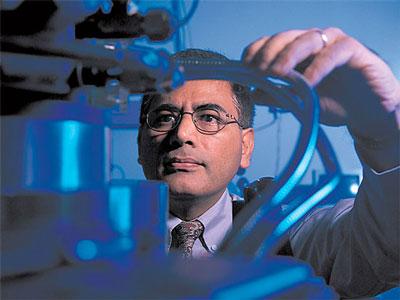 “We expose the students to frontier areas in materials research — not textbook projects, but high-risk, high-reward-type projects,” said Vohra.A 21-year program funded by the National Science Foundation has hosted undergraduate students for a summer of research at the University of Alabama at Birmingham. The students come from underrepresented groups and from schools where research opportunities are limited.
“We expose the students to frontier areas in materials research — not textbook projects, but high-risk, high-reward-type projects,” said Vohra.A 21-year program funded by the National Science Foundation has hosted undergraduate students for a summer of research at the University of Alabama at Birmingham. The students come from underrepresented groups and from schools where research opportunities are limited.
With a newly awarded grant from the NSF Division of Materials Research, this long-running experimental and computational materials research program now will continue another three years to 2021.
The $324,975 grant provides support for 10 undergraduate students per year, says Yogesh Vohra, Ph.D., principal investigator for the grant, Professor University Scholar, and associate dean in the UAB College of Arts and Sciences’ Department of Physics.
The program is extremely selective — less than 8 percent of applicants are offered positions. The program pays a generous stipend of $5,000 for 10 weeks’ duration, and it also pays for dorm expenses, travel, research supplies and conference travel.
“We expose the students to frontier areas in materials research — the design and discovery of new materials — not textbook projects, but high-risk, high-reward-type projects,” Vohra said. The students use state-of-the-art tools in materials growth and characterization, and computer modeling.
Vohra calls it the flagship undergraduate research program of the UAB Center for Nanoscale Materials and Biointegration. The student research projects are specifically developed for undergraduates by an interdisciplinary team of UAB science and engineering faculty at UAB.
| Besides helping young students find their careers, Vohra sees a critical national benefit from this NSF-funded program: “We help maintain U.S. competitiveness by developing a trained workforce in science, technology, engineering and math.” |
And UAB directly benefits when several of these high-achieving students return and join UAB graduate programs. “I have seen undergraduate students who are not sure of their research direction come back after their undergraduate research experience to join our UAB graduate program,” Vohra said. “They successfully complete their Ph.D.’s and have successful careers in academia, industry and national laboratories.”
During their 10-week stay, the students — who have diverse backgrounds in physics, chemistry, applied mathematics and engineering — also attend lecture series and a wide variety of workshops: materials growth and characterization, research ethics and professionalism, innovation and entrepreneurship, and preparation for graduate school. They publish their findings in peer-reviewed journals or present at professional meetings.
One example of publishing is Craig Johnson, a 2016 undergraduate student from St. Augustine’s University in North Carolina. Johnson published his research in the Journal of Physics: Condensed Matter in 2017, as first author.
The program attracts students from across the United States. The 2017 summer students, for example, came from Alcorn State University, Brigham Young University, Georgia College, North Carolina A&T State University, Oakwood University, San Diego State University, Smith College, Tuskegee University, the University of Florida, and the University of Memphis.
Besides helping young students find their careers, Vohra sees a critical national benefit from this NSF-funded program: “We help maintain U.S. competitiveness by developing a trained workforce in science, technology, engineering and math.”
Shane Catledge, Ph.D., a UAB associate professor in physics, is co-principal investigator in the grant.